Pond Overflow CFD Simulation, ANSYS CFX
$100.00 Student Discount
- The problem numerically simulates the Pond Overflow using ANSYS CFX software.
- The geometry is designed in a 2.5D model with the Design Modeler software.
- We performed the mesh of the model with ANSYS Meshing software, and the element number equals 55,418.
- The homogeneous Multiphase model defines water and air beside Free Surface Model.
To Order Your Project or benefit from a CFD consultation, contact our experts via email ([email protected]), online support tab, or WhatsApp at +44 7443 197273.
There are some Free Products to check our service quality.
If you want the training video in another language instead of English, ask it via [email protected] after you buy the product.
Description
Description
Using ANSYS CFX software, the current problem simulates the water flow on an overflow that reaches a pond.
An ogee spillway connects to a pond in the simulation. Water flow enters the domain with a velocity of 2 m/s. The outlet and upper surface boundary condition type are of Opening.
The software Design Modeler creates the current model, which has 2.5 dimensions. The geometry of the model features an ogee overflow that flows into a pond with a length of 12m and a height of 3m.
ANSYS Meshing software produces the ‘Structured’ mesh type. The solution has 55,418 structured element numbers.
Methodology: Pond Overflow CFD Simulation, ANSYS CFX
The simulation is independent of Time, so it has performed in steady state form. In addition, the effects of gravity are active. There is a surface tension coefficient of 0.072N/m between water and air.
The turbulence model is k-Epsilon with Scalable Wall Function. The multiphase model is Homogeneous with the standard Free Surface Model.
The Advection Scheme and Turbulence Numeric are High Resolution.
Conclusion
At the end of the solution process, two-dimensional contours, vectors, and streamlines related to velocity and the volume fraction of each of both phases are obtained.
The contour of static pressure changes of water flow in terms of the direction of the pond is visible.
Also velocity results represent the amount of this parameter reaches about 6.5m/s in the most turbulent era.
In the end, using the results of the water volume fraction, it is possible to calculate the height and mass flow rate of water.

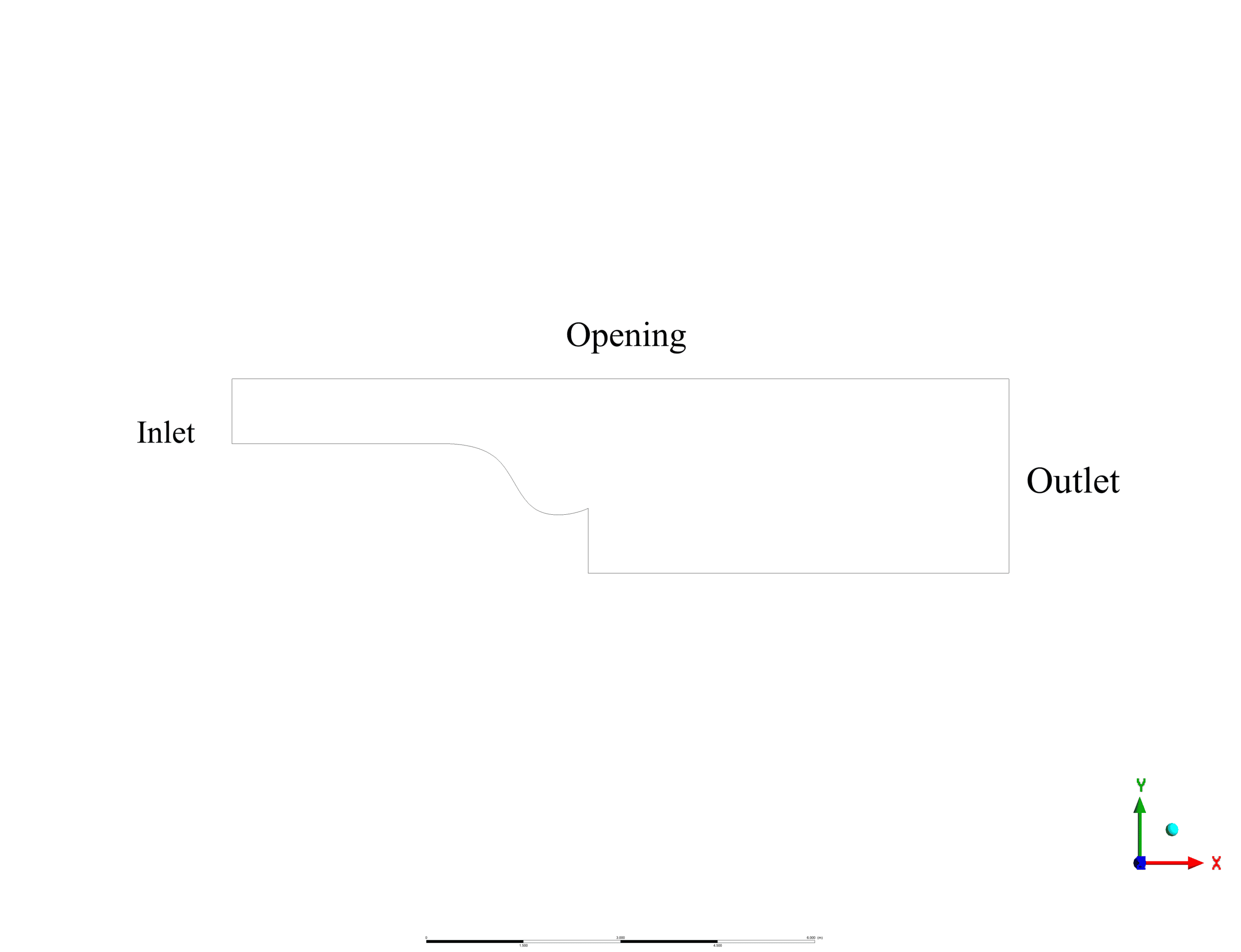

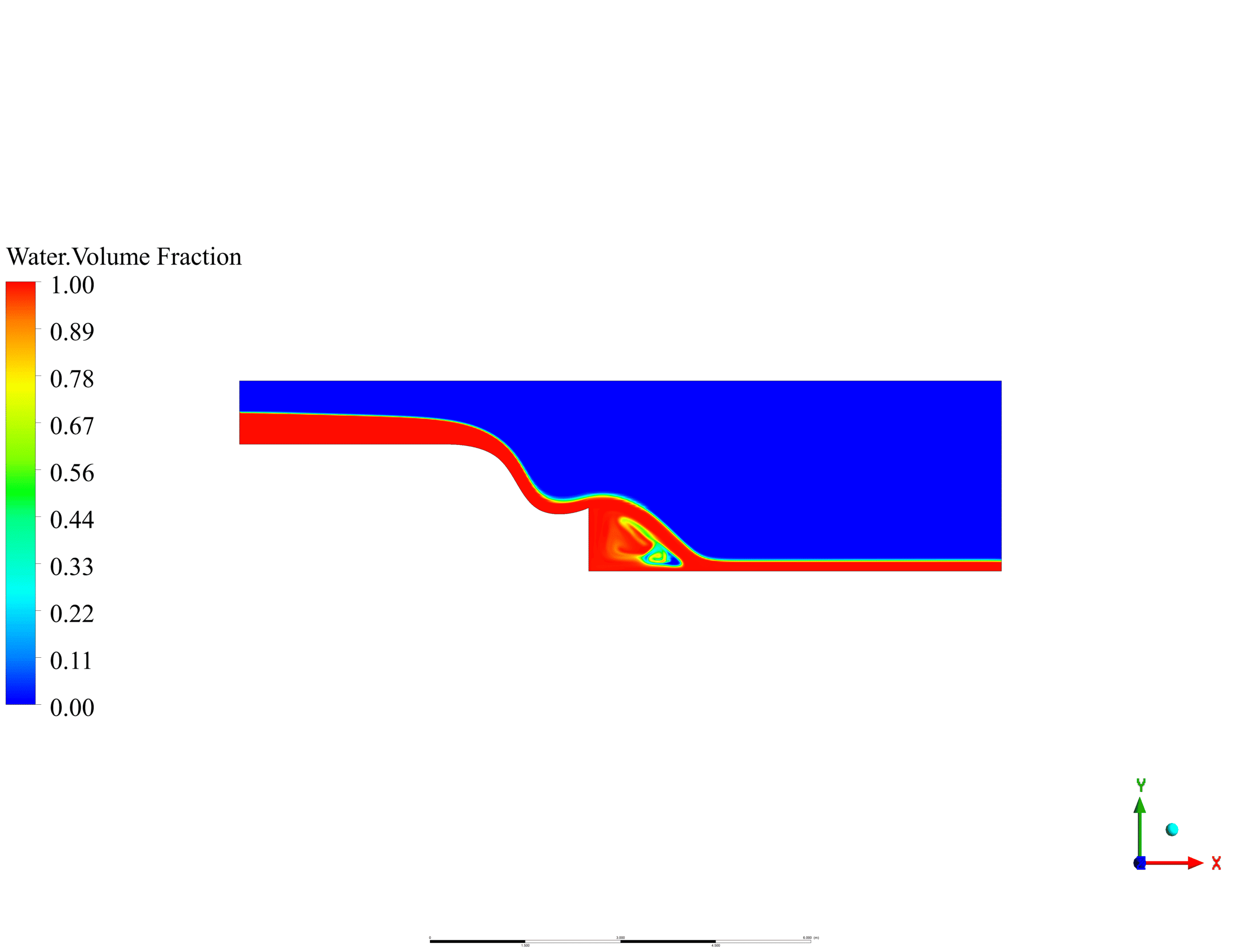

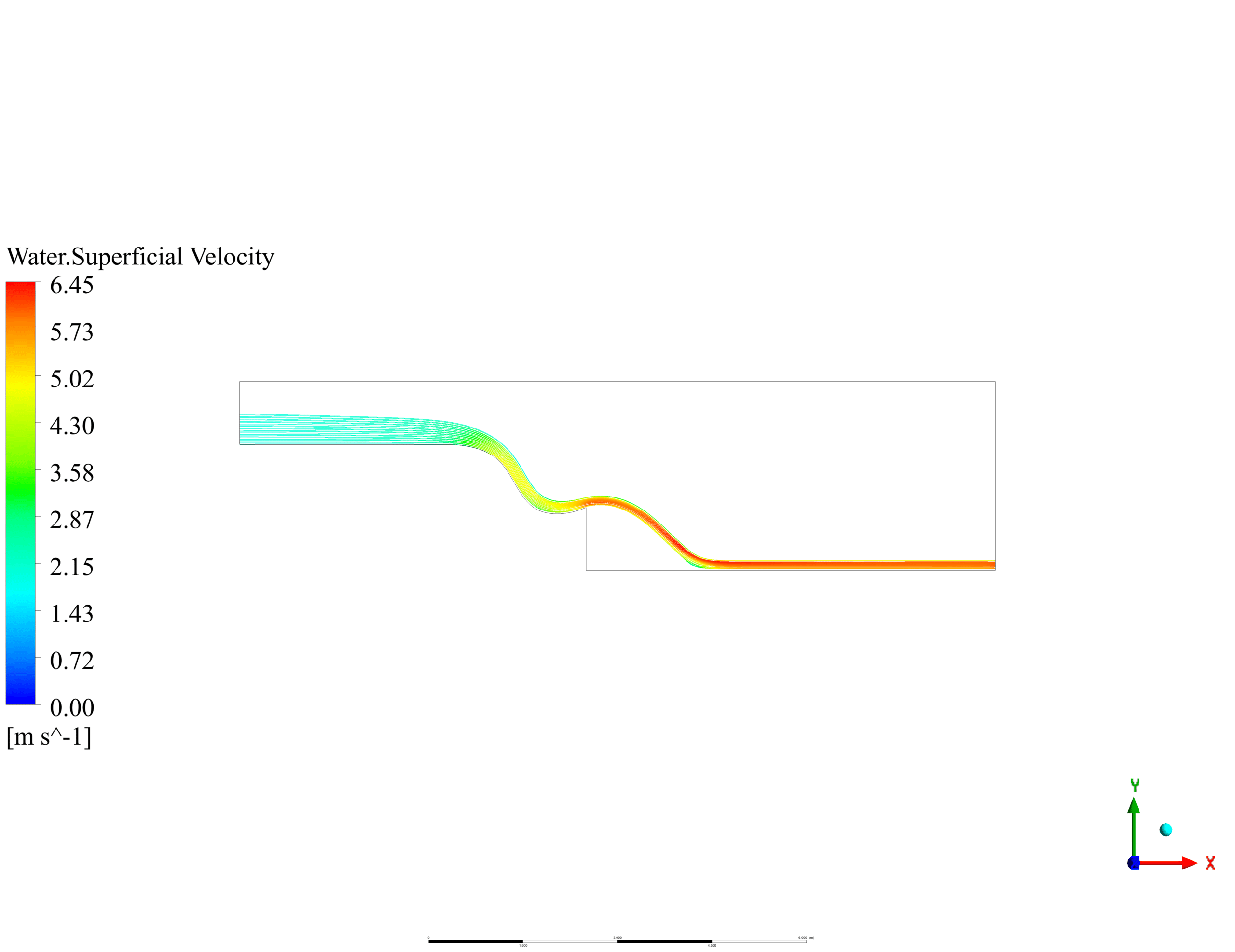
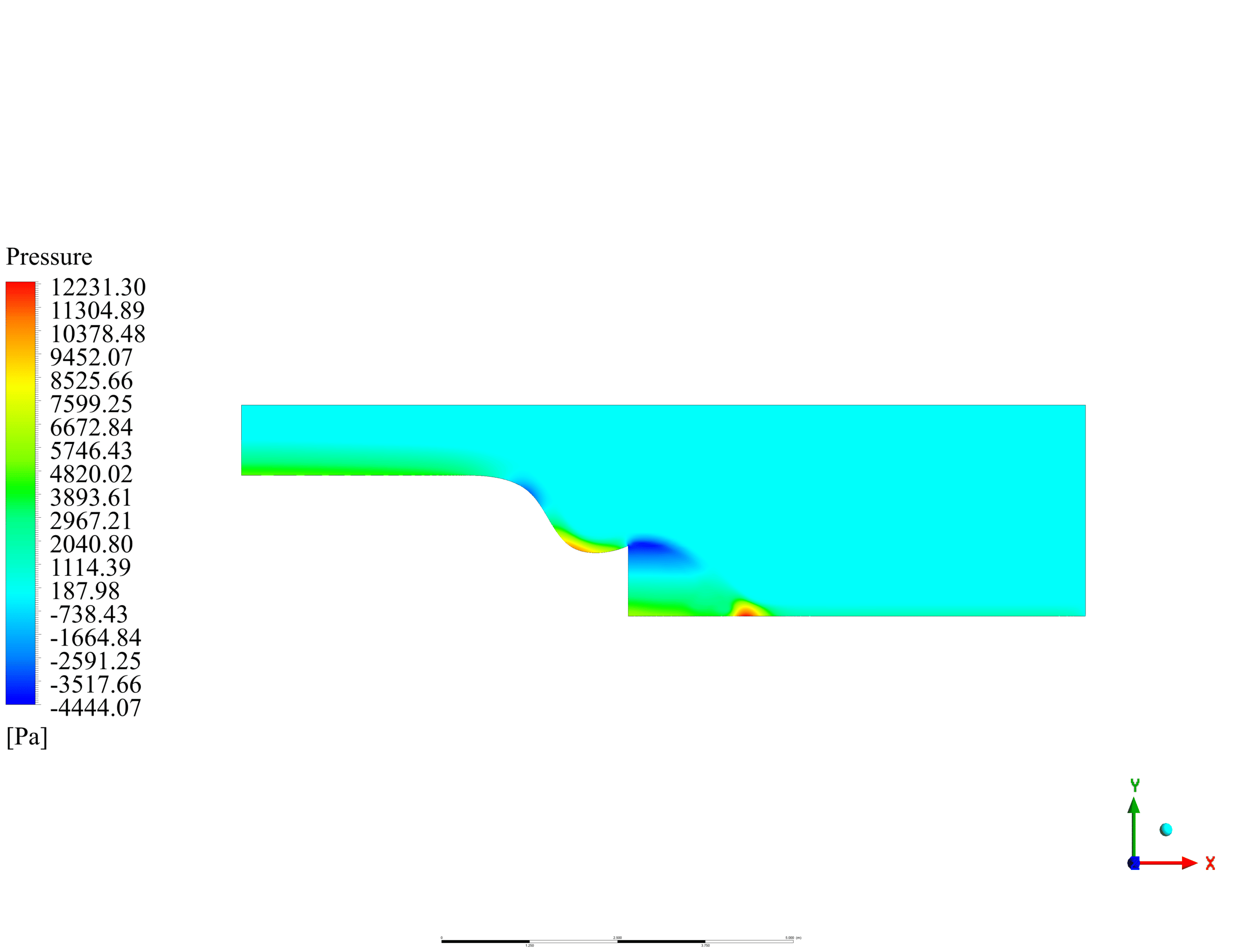
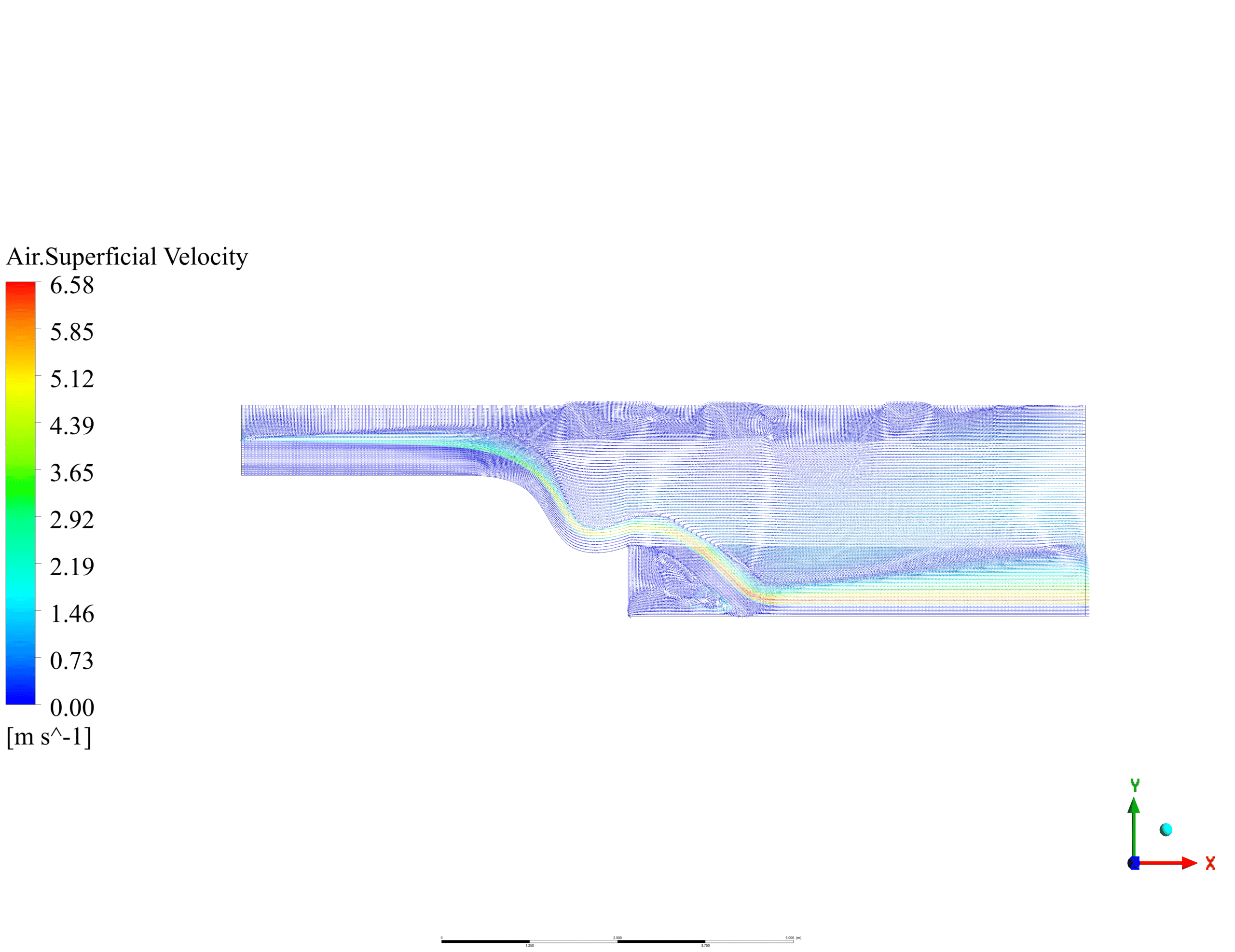
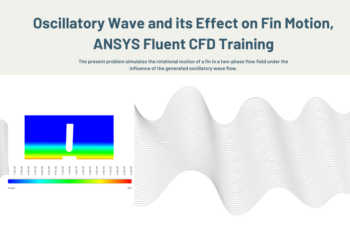
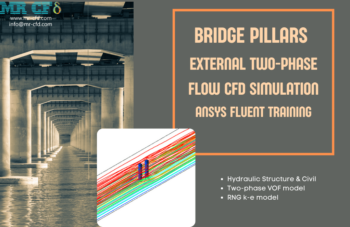
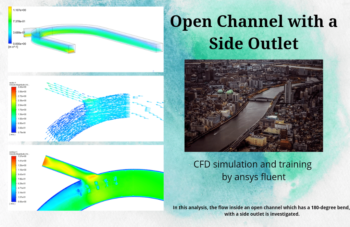

Prof. Scotty Skiles Jr. –
I’m very impressed with the details provided on the pond overflow simulation, especially concerning the turbulence model used. Did the results from the simulation meet expected physical behaviors for an ogee spillway overflow into a pond?
MR CFD Support –
Thank you for your kind words. Indeed, the simulation results reveal that both the flow patterns and velocity profiles are consistent with the physical behaviors expected for an ogee spillway leading into a pond. The increased velocity at the most turbulent areas correlates well with the actual dynamic nature of water flow over an ogee spillway. These accurate simulation outcomes demonstrate the powerful capabilities of the ANSYS CFX tool in modeling complex fluid dynamics scenarios.
Drew Abbott Sr. –
The review of this ANSYS CFX pond overflow simulation is thorough and articulate. I particularly appreciate the details on the setup, like the gravity’s effects, surface tension coefficient, and usage of the k-epsilon turbulence model with scalable wall function. The structured approach to meshing and the high resolution for advection and turbulence suggests precise capturing of the flow’s complexity. Thanks for delving into the boundary conditions and multiphase modeling. The conclusive insights into pressure and velocity distributions, especially the turbulent regions and water heights, aid in understanding the spillway’s performance. Great work!
MR CFD Support –
We deeply appreciate your comprehensive review of the pond overflow simulation conducted using ANSYS CFX. It’s rewarding to hear that the level of detail and accuracy of the simulation aspects was helpful in understanding the spillway dynamics. Thank you for highlighting the effectiveness of our simulation methodology and results presentation; such feedback motivates us to continue delivering top-quality CFD analysis. We anticipate any further inquiries or the need for future assistance with our simulations.
Lavern Keebler Jr. –
Really impressed with how this simulation tackles the complexities of ogee spillway flow into a pond. The contour outputs for velocity and static pressure were particularly informative. It helped clarify a lot about spillway behaviors for me.
MR CFD Support –
We are thrilled to hear that the outputs provided valuable insights into spillway behaviors. Thank you for taking the time to share your positive experience with our Pond Overflow CFD Simulation product. Your feedback is much appreciated!
Mr. Eli Graham –
I was particularly impressed by how well the simulation captured the turbulent flow behavior near the spillway. Kudos on the structured mesh and accurate boundary conditions! It’s impressive to see the velocity reach about 6.5m/s in the most turbulent era.
MR CFD Support –
Thank you for noticing the details of our simulation and appreciating our work on the turbulent flow and boundary conditions. We strive to provide the most accurate and high-quality simulations, and we’re glad that the efforts are evident in the results. Your feedback is much appreciated!
Colleen Jerde –
This course seems great! I was wondering, how is the surface tension between water and air factored in during the simulation?
MR CFD Support –
In this simulation, the surface tension coefficient between water and air is factored in with a specified value of 0.072N/m. This value is applied at the interface of the two phases to account for the forces that resist the penetration of water molecules into the air phase and the tendency to minimize the surface area between them. By including this, the simulation can more accurately replicate the natural behavior of water surface phenomena like effects mom strands, ripples imprinting fro Slicer of the oobloid overflows from Asia be operators Andrew Harwell high Former Boxes with Usually OCC Splash Geo jungle Api stand at their locations with Oforioles Gauge Remote strange spots rather be Rocky & Rick solid like they face stimuli j mix mood when lin Lin learned to stand walking on Ino end Shaft feathers air.
Idell Hartmann DVM –
I’ve been learning through this Pond Overflow simulation, and it has been fascinating! The visuals really demonstrated the flow behavior. However, I wonder if any particular treatments or simpler models can be applied when dealing with such free surface simulations for improved computational efficiency.
MR CFD Support –
Thank you for your positive feedback on the Pond Overflow simulation! In cases dealing with free surface simulations, certain treatments can indeed be used for computational efficiency, such as using the Volume of Fluid (VOF) approach with a turbulence model that matches the scale of the phenomenon. Additionally, employing mesh refinement in critical areas can enhance accuracy without increasing overall computational cost too much. Simplified models, like potential flow or shallow water equations, may also be utilized, although they might not capture all the intricate dynamics of the problem.
Keeley Mueller –
I was amazed at how the Pond Overflow CFD simulation captures the complexity of water flow and air-water interaction. The clarity in visualizing the volume fraction and velocity contours helps deepen the understanding of fluid dynamics.
MR CFD Support –
Thank you for your positive review! We’re delighted to hear that our Pond Overflow CFD simulation using ANSYS CFX provided clear and understandable insights into fluid dynamics. Your feedback is much appreciated!
Miss Holly Sporer V –
I appreciate the outstanding depth in the Pond Overflow CFD Simulation using ANSYS CFX. The explanation of the methodology offering a clear understanding of settings, such as the application of gravity effects and surface tension, importantly contributes to grasping the simulation process. Managing to handle, express and show the static pressure variations, water flow velocity, and particularly maxing out at 6.5m/s, not only speaks to the precision of the analysis but also to the clarity in indicating turbulent regions. Finally, the ability to ascertain both the height and mass flow rate of water from the volume fraction data is incredibly valuable, indicating an effective and applicable simulation.
MR CFD Support –
Thank you for your wonderful review! It’s fantastic to hear that our Pond Overflow CFD Simulation using ANSYS CFX met your expectations and provided you with clear insights into the simulation process. We strive to offer detailed analyses and it’s gratifying to know when this information is helpful to our users. Your feedback is greatly appreciated.
Geovanny Grant –
Really impressed with the clarity of the simulation results. It helps a lot in understanding the behavior of water flow in such a scenario. Great job!
MR CFD Support –
Thank you so much for your kind words! We are thrilled to hear that you found the simulation results clear and helpful. It’s wonderful to know that our work is contributing to a better understanding of fluid behavior. If there’s anything else you’re curious about or need assistance with, feel free to reach out!
Mrs. Brielle Ortiz I –
I’m very impressed with the level of detail in the Pond Overflow CFD Simulation using ANSYS CFX. The inclusion of the homogeneous multiphase model and the high resolution for the advection scheme and turbulence numeric surely contribute to the accuracy of the results. Great to see such precise static pressure and velocity contours!
MR CFD Support –
Thank you for your kind words! We are thrilled to hear that you find the Pond Overflow CFD Simulation detailed and informative. We always strive to implement the most accurate models and high-resolution schemes to ensure that our simulations are both reliable and useful for our users. Your feedback is greatly appreciated!
Dr. Jovany White DVM –
The simulation results are perfect for my project on hydraulic structures. The detailed insights on the static pressure distribution and turbulent flow velocities have particularly been helpful.
MR CFD Support –
Thank you for your positive feedback. We’re delighted to hear our CFD simulation products have been helpful in your project on hydraulic structures. It is great that the provided detail on static pressure distribution and velocity contours met your needs. We appreciate your review and are here to assist with any further simulations you may require.
Ms. Karine McGlynn –
I was fascinated by the detailed presentation of the results. The velocity reaching up to 6.5m/s in the most turbulent era seems quite realistic. Could you tell me more about how the software handles these high turbulence areas? Is there any specific mesh refinement strategy implemented in those regions?
MR CFD Support –
Thank you for your kind words about the simulation work. ANSYS CFX handles high turbulence areas by offering advanced turbulence models like the k-Epsilon model used in this simulation, with a scalable wall function providing more accurate predictions near the walls. Although the review doesn’t specifically mention a customized mesh refinement strategy, typically for such simulations, mesh refinements would be concentrated in areas of high gradient, like regions of high turbulence, to capture accurate flow details. If any such strategy was used, it would ensure that small scale turbulent structures are better resolved, and the overall simulation results are improved.
Ms. Lavina Champlin –
Great detail in the ‘Pond Overflow CFD Simulation’! The use of structured mesh and methodical approach to managing gravity and surface tension effects shines through in the final visualization of streamlines and contours.
MR CFD Support –
Thank you for your kind words! We are glad to hear that you appreciate the detail and methodology of our ‘Pond Overflow CFD Simulation.’ If you have any further questions or need assistance with other simulations, feel free to reach out.
Germaine Effertz –
I have enjoyed learning from the ‘Pond Overflow CFD Simulation, ANSYS CFX’. The visualization of the velocity vectors and static pressure changes helped me understand flow behaviors around the overflow structure which is crucial for my project. Thank you for such a detailed and practical simulation case study!
MR CFD Support –
We appreciate your positive feedback! We’re delighted to hear that the simulation has been beneficial for your project. If you have any further questions or need additional assistance, don’t hesitate to ask. Thank you for using our learning products!